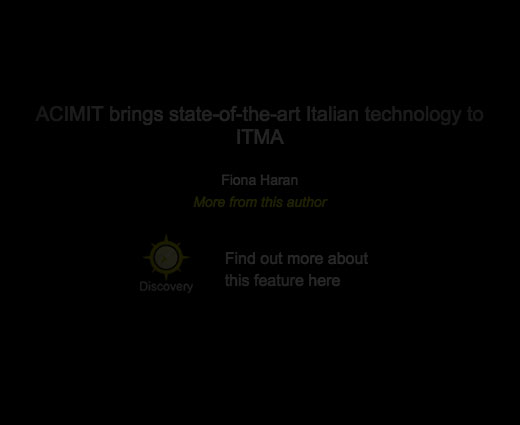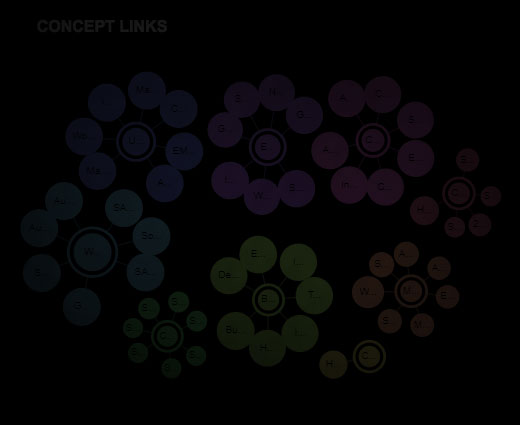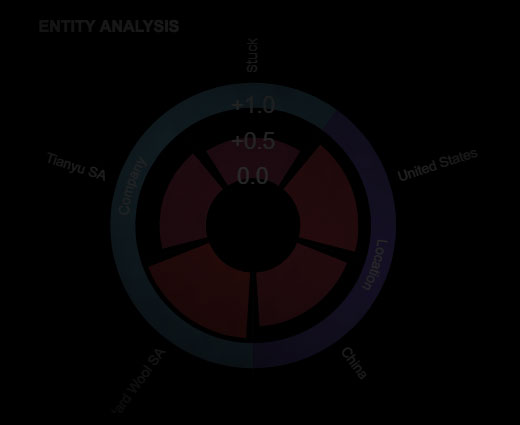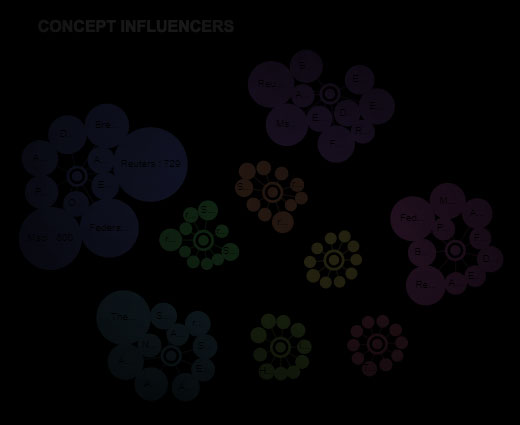The Smartgeometry workshop and conference is held every two years at a different location around the world – previously in New York and London, and this year in Toronto, Canada, back in May. Computing and engineering underpin much of the work and discussion, with systems and materiality a strong focus. With this year’s theme of Machine Minds there was much potential interest for the textile and fashion sector, a fact emphasised by the presence of keynote speakers Dan Price of Adidas and Philip Beesley, a long-time collaborator with Iris van Herpen.
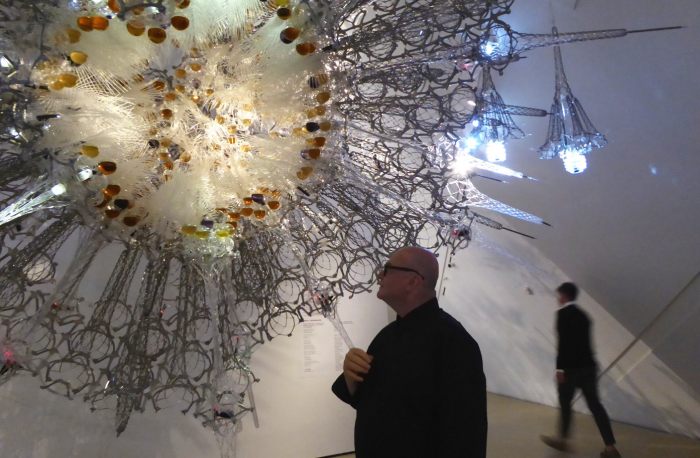 Philip Beesley with one of Noosphere’s three spherical volumes exhibited as part of Philip Beesley: Transforming Space at the Royal Ontario Museum (ROM). The title for the ‘living lab’ is taken from Teilhard de Chardin’s use of the term to evoke the earth’s next stage of evolution.
Philip Beesley with one of Noosphere’s three spherical volumes exhibited as part of Philip Beesley: Transforming Space at the Royal Ontario Museum (ROM). The title for the ‘living lab’ is taken from Teilhard de Chardin’s use of the term to evoke the earth’s next stage of evolution.
Photo: Marie O’Mahony
Founded in 2001 by members of the world’s leading architecture and engineering practices and academic institutions, Smartgeometry forges an alliance between industry, academia and research. Interdisciplinarity is key and spans the highly conceptual as well as physical outcomes of the workshops that precede the two-day conference. This year’s event, hosted at the John H Daniels Faculty of Architecture, Landscape and Design at University of Toronto, examined the subject of machine intelligence. Artificial intelligence (AI) took center stage, but through an array of historical, contemporary and future focused perspectives. One of the most interesting sub-themes to emerge from a textile point of view was AI through the lens of biomimicry.
Biomimicry is the extraction of good design from nature. Velcro is an example of this as it was inspired by the hook and fasten system used by burdock seeds to transport planting to a wider geographical area by attaching itself to the fur of a passing animal. Structures such as bamboo have been the focus of research into materials with a high weight to strength ratio such as composites. None of these examples use machine intelligence, but what could happen if AI was used in the development of new materials?
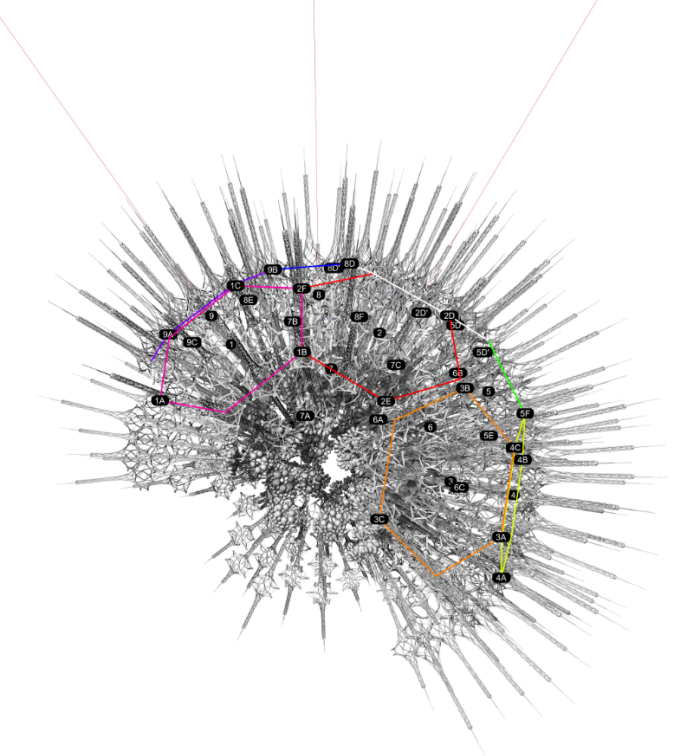
The diagram shows the key locations of underlying spatial sound and microprocessor systems located within the dome of the Noosphere sculpture.
Photo: © PBAI/LAS
David Benjamin is founding principal of The Living, with his work focusing on expanding the definition of environmental sustainability through the multiple frameworks of biology, computation and the circular economy. High volumes of composites are already being used in aircrafts, but the development of a Bionic Partition allows for a weight saving of 50% plus greater strength. Using a combination of generative design tools with 3D printing and advanced materials, a bespoke dividing wall can be created that provides strength where needed (such as around the attendant seating area) and minimising material used where it is not. The design is a collaboration between The Living, Airbus, Autodesk and APWorks serving to highlight the complexity attached in the development of a bespoke system reliant on AI. One of the issues with generative design historically is that, “the technology is only as good as the data we feed it” according to Autodesk’s Alex Tessier. In adopting a biological approach, tens of thousands of design options can be explored. Benjamin says: “used well it can enhance human creativity […] it can remove some of the blind spots in human creativity.”
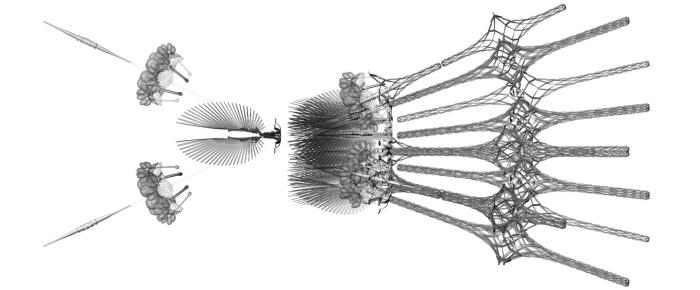 Exploded view of Noosphere dome scaffold system including thermally expanded diagrid skeleton frames, glass manifolds, digitally controlled LED lights
Exploded view of Noosphere dome scaffold system including thermally expanded diagrid skeleton frames, glass manifolds, digitally controlled LED lights
and vibrating frond mechanisms
Photo: © PBAI/LAS
Dan Price is director of Simulation Engineering at Adidas’ Future Team, which applies advanced engineering simulation to enable process, production and ultimately new product innovation within the brand. One of the more unexpected in which it is looking at digital and materials is through sound engineering and the football interaction experience whether kicking, heading or controlling. “We are interested in engineering quality and there is an element of sound and perception,” says Price. “In the same way that the automotive industry might engineer the sound of a door closing, we might use the same sort of thing with our ball products.” The data gathered digitally, using spectroscopy in specially constructed sound chambers to gain better understanding of the frequencies that relate to a particular sound, is then used to engineer the materials and construction to get the sound that they are looking for.
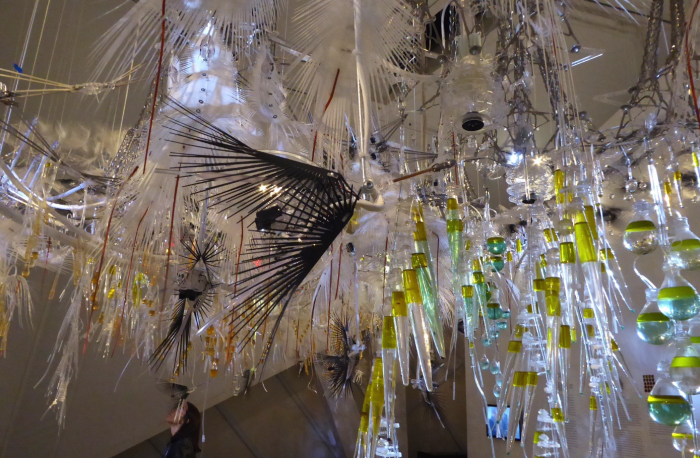 Iris van Herpen’s Dome Dress (2017), showing collaborator Philip Beesley’s Aegis suspended canopy with an evolving intelligent soundscape developed with Salvador Breed and 4DSOUND. Exhibited as part of Iris van Herpen: Transforming Fashion at the Royal Ontario Museum (ROM)
Iris van Herpen’s Dome Dress (2017), showing collaborator Philip Beesley’s Aegis suspended canopy with an evolving intelligent soundscape developed with Salvador Breed and 4DSOUND. Exhibited as part of Iris van Herpen: Transforming Fashion at the Royal Ontario Museum (ROM)
Photo: Royal Ontario Museum
Within the fashion and textile industries, human and electronic eyes are used to find flaws in material and garment construction. These are usually repaired or removed, but what if they were identified and highlighted to become the focal point of the final product? This is what The Living has done with wood in the new Embodied Computation Lab commissioned by Princeton University. In designing the fabrication space, The Living looked to create a sustainable building using reclaimed wood from scaffolding structures and to use it in a way that pushed the limits of wood as a construction material. For the first part of the process images of wood with knots were posted on a website with humans identifying the knots. A customised machine algorithm then analysed the data to detect and identify knots in subsequent images of wood. A special CNC machine was then developed to sand-blast knots to expose their micro-contours. 900 reclaimed boards were then sorted and arranged according to their colour tone and knots. The boards for the building façade were then laid out to match solar analysis with targeted thermal insulation based on the micro-contours. Sensors were placed behind the wood to gather data over the lifetime of the building. Aesthetics revolve around the knots, with shifting shadows over the day and weathering over time creating a dynamic surface.
Philip Beesley is a multidisciplinary artist and architect. He leads the Living Architecture Systems Group of international researchers and creative working on the next generation of interactive environments. Much of what we are seeing in this space from a fashion perspective revolves around Augmented Reality (AR) sensors. Beesley’s work is firmly tethered to materiality, with the digital element carried out behind the scenes. He represented Canada at the Venice Biennale in 2010 with Hylozoic Ground, creating an artificial forest of intricate transparent acrylic ‘fronds’ fitted with sensors and actuators responding to human presence. One of the visitors that it impressed was the Dutch fashion designer Iris van Herpen and the two began a series of collaborations in 2013. Their most recent collaboration has been on a Dome Dress from van Herpen’s Aeriform Collection (Fall 2017) with the garment acquired by the Royal Ontario Museum (ROM), where both are exhibiting in 2018. The dress is made from more than 300 pieces of zinc-coated steel that took 62 hours to lasercut before being hand-moulded into 3D forms in a process that took 240 hours.
From the First Industrial Revolution to the current preoccupation with Industry 4.0, humans have looked to find the best way to work with technology. Throughout Smartgeometry 2018, these processes and future scenarios have ben considered, discussed and explored in a very real way through both digital and physical outcomes. In textiles and in fashion, biomimicry has been relatively slow to produce fully commercial outcomes. A large part of this can be attributed to an overly literal interpretation of nature. While we are no longer trying to fly with mechanical ‘wings’ strapped to our arms, as this conference shows, we still have quite a way to go if we are to really exploit the lessons to be learnt from nature.
*Marie O’Mahony writes and consults for the textile and apparel industry. She is the author of several books on advanced and smart textiles published by Thames and Hudson
Have your say. Tweet and follow us @WTiNcomment
RELATED ARTICLES
-
Advanced technologies assist design
- Laura Syrett
- WTiN
-
Water-based inks for apparel printing
- Active Apparel Group
- WTiN
-
Accelerating Circularity cotton report launch
- Accelerating Circularity
- WTiN
-
News Release
Circularity panel at functional fabric fair
-
News Release
Emtec Electronic rethinks textile haptic analysis



